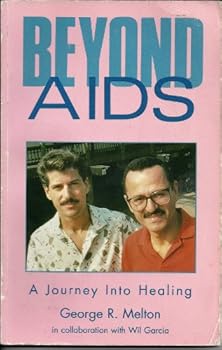Beyond AIDS: A Journey into Healing
This is a collectible First Edition in very good condition with minimal creasing on the covers. Pagination is without any marking or blemish. This description may be from another edition of this product.
Format:Paperback
Language:English
ISBN:0962195901
ISBN13:9780962195907
Release Date:January 1988
Publisher:Brotherhood Pr
Length:145 Pages
Weight:0.40 lbs.
Dimensions:8.3" x 0.5" x 5.3"
Related Subjects
General Health Health, Fitness & Dieting Health, Fitness & Dieting Medical Books MedicineCustomer Reviews
1 rating
New Paradigm Material
Published by Thriftbooks.com User , 15 years ago
I read this book several years ago, and recommend it highly. The authors (also Wil Garcia) are a gay couple who contract AIDS, and then pursue help first in medical treatment. While today retrovirals can provide some protection if they continue to be taken, Merton and Garcia show how the mind-body approach ultimately was able to heal them even years ago. Carl Simonton, MD had insights as an oncologist, and wrote his book Getting Well Again in 1978, and Merton and Garcia were exposed to his work in their search. The diversity of their search is interesting. Ultimately, however, there is no input from their attending physicians, unfortunately. To put this book in its proper scientific context, therefore, it can be helpful to read Simonton's book, and Herbert Benson's The Relaxation Response for starters. Other MDs are doing great work too, and I think Dean Ornish, MD's Love and Survival and Bernie Siegel's Love, Medicine, and Miracles make more great resources for further corroboration. It is also worth noting that psychosomatic medicine, or psychoneuroimmunology, achieved new levels of recognition in the 1990s when Benson opened a mind-body institute in Boston, MA. UCLA has named their own institute since then after Norman Cousins, a literary celebrity who became famous for his own successful healing through laughter. Patch Adams' work is worth remembering in this light. Harvard and Columbia are two other medical schools with psychosomatic institutes, or what is called "Complementary and Alternative Medicine" or "CAM." The US government's National Institute of Health also atarted a CAM program in the 1990s, and funds over 200 institutes. Laboratory studies are in this field are still in the early stages of the scientific study of this complex phenomenon, despite the founding of the journal Psychosomatic Medicine in the 1940s. Nevertheless, much of the laboratory work is conducted with highly restricted focus. The big healing breakthroughs will be demonstrated by individuals who can apply themselves and recognize their own psychosomatic nature. I recommend some basic neuroscience to grasp this basic reality more effectively. I have a college textbook on neuropsychology by Kolb and Whishaw, but I'm sure there must be great books out there on neuroanatomy and the like. I think a helpful analogy to distinguish the different scientific approaches involved might be evolution. On the one hand, they can identify genetic markers now like Spencer Wells' accounts of the migrations from Africa, like the differences between the Australian Aborigines and New World Native Americans. On the other hand, even earlier, the Leakey's discovery of Lucy the Australopithecine established a solid foundation of our African biological origins, while through linguistic studies, we already could perceive the cultural correlates of diverse human flows that have occurred. My comments, then, are intended to help support





